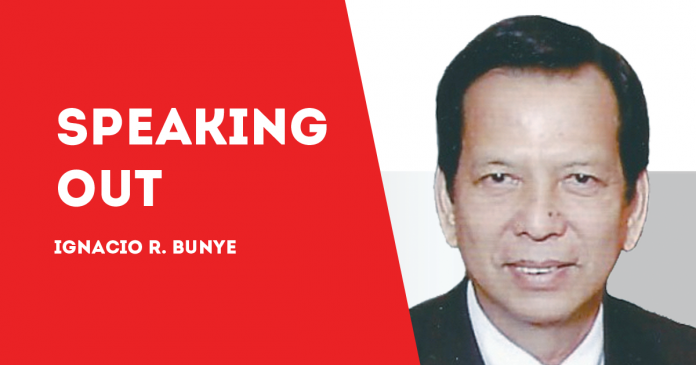
HISTORY will judge our 14th president, Gloria Macapagal Arroyo, as one of the two most significant women in the history of the Philippines. The other is her one-time mentor, our 11th President, Corazon Aquino. No other women in our history come close to the role they played in our nation’s saga, even if we go back in time to a Gabriela Silang or to a Princess Urduja. When posterity looks back to how the modern-day Philippines became democratically free and economically strong, its gaze will be on the 1986 people power and on the 2005 fiscal reforms.
Thus I felt very honored to be part of the virtual launching of President Arroyo’s book, Deus Ex Machina, last Wednesday. it is President Arroyo’s story in her own words, told and published during her lifetime.
Why “Deus Ex Machina”? The term (literally “god from machine”) derives from Greek drama, where a god appears in a shining chariot at a critical point and solves a seemingly unsolvable problem. In modern times, the term that comes closest is “divine intervention” or more appropriately “divine providence”. President Arroyo firmly believed in Divine Providence. Her late father, President Diosdado Macapagal, had consistently drilled into his daughter “In every thing that you do, do what is right, do your best and God will take care of the rest.”
The book was published by the Manila Bulletin Publishing Corporation and was launched fortuitously on Feb. 2, 2022, the 122nd anniversary of The Manila Bulletin.
President Arroyo stated that there will actually be two memoirs. The first one, consisting of 216 pages is anecdotal in style and targets the casual reader. The second version, probably twice as long, will be more analytical and designed for the researcher type. Consisting of seven parts, Book One narrates various phases of the author’s life, namely: 1. Roots; 2. Striking Out On My Own; 3. Public Service; 4. Madame Senator to Madame Vice President; 5- 6. Her Presidency; 7. Congresswoman Gloria and Madame Speaker.
The virtual book launch was attended by the President’s family and former senior officials of her administration. Also present were political leaders of the province of Pampanga, leaders of political parties to which she had been affiliated, persons who played a key role in the publication of the book and members of media. Archbishop Emeritus of the Archdiocese of San Fernando, Pampanga, Archbishop Paciano Basilio Aniceto, led the opening prayer.
Vice President Noli de Castro received the first autographed copy of the book. In his own foreword, Kabayan described the metamorphosis of the author from two perspectives.
“As a member of the Fourth Estate, I saw and followed her phenomenal rise from a minor bureaucrat into one of the country’s political celebrities who attracted both throngs of admirers and cabals of dedicated adversaries. From the media viewpoint, Gloria Macapagal Arroyo had “star quality” – one that would endear her to the masses and, at the same time, trigger ire and envy in others.
“As a member of her Cabinet, I was given a first-hand view of the quality of her character. Of Gloria Macapagal Arroyo, it must be said that she had exceptional quality of vision for the nation and tensile strength matched only by a few of her peers.
“Serving the nation in tandem with her was not a walk in the park. It seemed her adversaries never slept. They dedicated themselves to keep the black propaganda machinery working. Gloria Macapagal Arroyo, however, knew what needed to be done for the country to prosper. With nerves of steel and unmatched determination, she accomplished them.”
Chairman Emeritus and owner of the Manila Times, Secretary Dante Ang, credits President Arroyo with guiding progressive developments, among them The Export Development Act, the 1995 Mining Act, the Electric Power Industry Act (EPIRA) and the creation of the Nautical Highway.
Dr. Emil Yap, President and Vice Chairman of Manila Bulletin said: “It is a very good read. There is a lot in this book that anyone interested in Philippine history in general and PGMA’s life in particular, can pick up. It is always interesting to see things from the point of view of those who actually had a hand in making things happen.”
Former Executive Secretary Eduardo R. Ermita recalled his association with the President. “I was impressed by the President’s decisiveness in moments of crisis. With strength of character, she warded off destabilization attempts during her administration by issuing strategic directions to her cabinet. (She was) a leader who was resolute, confident, steadfast.”
Up close and personal, I also had the opportunity to observe her best traits- hard work, discipline, decisiveness, patriotism and a deep abiding faith. Her lasting legacy was growing the economy and significantly reducing the country’s poverty incidence. Her fiscal reform of 2005 (read that as EVAT) significantly turned our economy around. From 74 billion dollars in 2001, our economy nearly tripled to $200 billion in 2010. The country experienced 38 continuous quarters of economic growth while the poverty rate dropped by 13 percent, from 39 to 26 percent.
***
Note: You may wish to share the foregoing via Facebook, Twitter, Linked-In or Viber./PN





